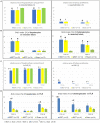The Interplay Between Biliary Occlusion and Liver Regeneration: Repeated Regeneration Stimuli Restore Biliary Drainage by Promoting Hepatobiliary Remodeling in a Rat Model
- PMID: 35548189
- PMCID: PMC9081651
- DOI: 10.3389/fsurg.2022.799669
The Interplay Between Biliary Occlusion and Liver Regeneration: Repeated Regeneration Stimuli Restore Biliary Drainage by Promoting Hepatobiliary Remodeling in a Rat Model
Abstract
Background and aims: Patients with malignant biliary obstruction do not seem to benefit from "two-stage hepatectomy" due to an impairment of liver regeneration. We designed a novel model of "repeated regeneration stimuli" in rats mimicking a "two-stage hepatectomy" with selective or complete biliary occlusion mimicking Klatskin tumors III° or IV°. Using this new model, we wanted to investigate (1) the impact of preexistent cholestasis of different extent on the time course of liver regeneration and (2) the dynamics of hepatobiliary remodeling under regeneration conditions.
Materials and methods: Rats were subjected to a sequence of three operations: surgical induction of biliary occlusion, followed by "repeated regeneration stimuli" consisting of ligation of the left branch of the portal vein (supplying 70% of the liver volume, sPVL) as first stage and a 70%-hepatectomy (70%PHx) as second stage. Biliary occlusion (1st procedure) was induced by ligating and transection of either the common (100%, tBDT) or the left bile duct (70%, sBDT). A sham operation without ligating the bile duct was performed as control (0%, Sham). Two weeks later, on day 14 (POD14), the sPVL (2nd procedure) was performed. Another week later (POD 21), the 70%PHx (3rd procedure) took place and animals were observed for 1 week (POD 28). The first experiment (n = 45 rats) was dedicated to investigating liver regeneration (hypertrophy/atrophy), proliferative activity and hepatobiliary histomorphology (2D-histology: HE, BrdU) in the future liver remnant (FLR). The second experiment (n = 25 rats) was performed to study the dynamics of hepatobiliary remodeling in livers with different regenerative pressure (tBDT only POD21 vs. tBDT only POD 28 vs. tBDT + sPVL vs. tBDT + 70%PHx vs. tBDT + sPVL + 70%PHx) using μCT scans of explanted livers.
Effect of biliary occlusion: Total biliary occlusion (tBDT) led to a 2.4-fold increase in whole liver volume due to severe biliary proliferation within 14 days. In contrast, partial biliary occlusion (sBDT) caused only a volume gain of the obstructed liver lobes due to biliary proliferates, resulting in a minor increase of total liver volume (1.7-fold) without an increase in bilirubin levels.
Liver regeneration and atrophy: As expected, sPVL caused substantial volume gain (tBDT: 3-fold; sBDT: 2.8-fold; Sham 2.8-fold) of FLR and a substantial volume loss (tBDT: 0.9-fold; sBDT: 0.6-fold; Sham: 0.4-fold) of the portally deprived "future resected lobes" compared to the preoperative liver volume. The subsequent 70%PHx promoted a further volume gain of the FLR in all groups (tBDT: 4-fold; sBDT: 3-fold; Sham 3-fold compared to original volume) until POD 28. Hepatobiliary remodeling: After tBDT, we identified histologically three phases of hepatobiliary remodeling in the FLR. Following tBDT, biliary proliferates developed, replacing about 15% of the hepatocellular tissue. After sPVL we found incomplete restoration of the hepatocellular tissue with a visible reduction of the biliary proliferates. The 70%PHx led to an almost complete recovery of the hepatocellular tissue in the FLR with a nearly normal liver architecture. In contrast, after sBDT and Sham we observed a near normal liver morphology in the FLR at all time points. CT-scanning of the explanted livers and subsequent 3D reconstruction visualized the development of extrahepatic biliary collaterals. Collaterals were detected in 0/5 cases 1 week after sPVL (first regeneration stimulus), and in even more cases (3/5) 1 week after the 70%PHx (second regeneration stimulus). Histological workup identified the typical biliary cuboid epithelium as inner lining of the collaterals and peribiliary glands.
Conclusion: Liver volume of the FLR increased in cholestatic rats mainly due to biliary proliferates. Application of repeated regeneration stimuli in the style of a "two-stage hepatectomy" promoted almost full restoration of hepatocellular tissue and architecture in the FLR by reestablishing biliary drainage via formation of biliary collaterals. Further exploration of the dynamics in hepatobiliary modeling using this model might help to better understand the underlying mechanism.
Keywords: biliary decompression; experimental surgery; hepatobiliary remodeling; liver resection; occlusive cholestasis; portal vein ligation; regeneration stimuli.
Copyright © 2022 Richter, Sänger, Mussbach, Scheuerlein, Settmacher and Dahmen.
Conflict of interest statement
The authors declare that the research was conducted in the absence of any commercial or financial relationships that could be construed as a potential conflict of interest.
Figures



Similar articles
-
Selective biliary occlusion in rodents: description of a new technique.Innov Surg Sci. 2022 Jun 23;7(1):13-22. doi: 10.1515/iss-2021-0044. eCollection 2022 Mar 1. Innov Surg Sci. 2022. PMID: 35974775 Free PMC article.
-
Intrahepatic Size Regulation in a Surgical Model: Liver Resection-Induced Liver Regeneration Counteracts the Local Atrophy following Simultaneous Portal Vein Ligation.Eur Surg Res. 2016;57(1-2):125-37. doi: 10.1159/000446875. Epub 2016 Jun 17. Eur Surg Res. 2016. PMID: 27308828
-
Corrosion Cast and 3D Reconstruction of the Murine Biliary Tree After Biliary Obstruction: Quantitative Assessment and Comparison With 2D Histology.J Clin Exp Hepatol. 2022 May-Jun;12(3):755-766. doi: 10.1016/j.jceh.2021.12.008. Epub 2021 Dec 20. J Clin Exp Hepatol. 2022. PMID: 35677523 Free PMC article.
-
Improving the Safety of Major Resection for Hepatobiliary Malignancy: Portal Vein Embolization and Recent Innovations in Liver Regeneration Strategies.Curr Oncol Rep. 2020 May 16;22(6):59. doi: 10.1007/s11912-020-00922-x. Curr Oncol Rep. 2020. PMID: 32415401 Review.
-
Associating liver partition and portal vein ligation for staged hepatectomy (ALPPS): a new strategy to increase resectability in liver surgery.Int J Surg. 2014;12(5):437-41. doi: 10.1016/j.ijsu.2014.03.009. Epub 2014 Apr 2. Int J Surg. 2014. PMID: 24704086 Review.
References
-
- Schnitzbauer AA, Lang SA, Goessmann H, Nadalin S, Baumgart J, Farkas SA, et al. . Right portal vein ligation combined with in situ splitting induces rapid left lateral liver lobe hypertrophy enabling 2-staged extended right hepatic resection in small-for-size settings. Ann Surg. (2012) 255:405–14. 10.1097/SLA.0b013e31824856f5 - DOI - PubMed
LinkOut - more resources
Full Text Sources
Research Materials

